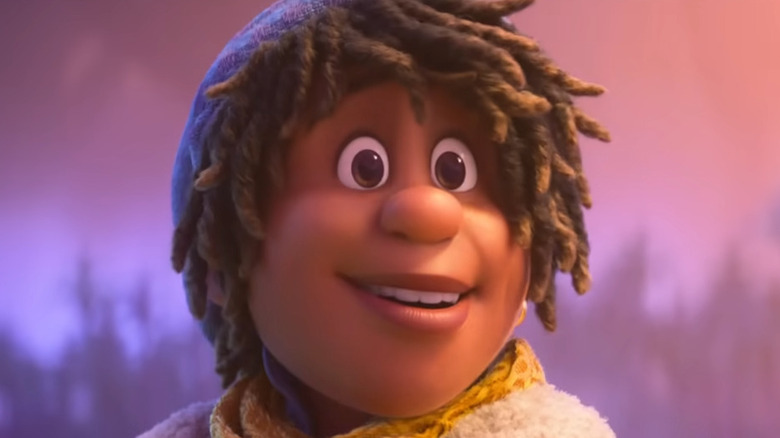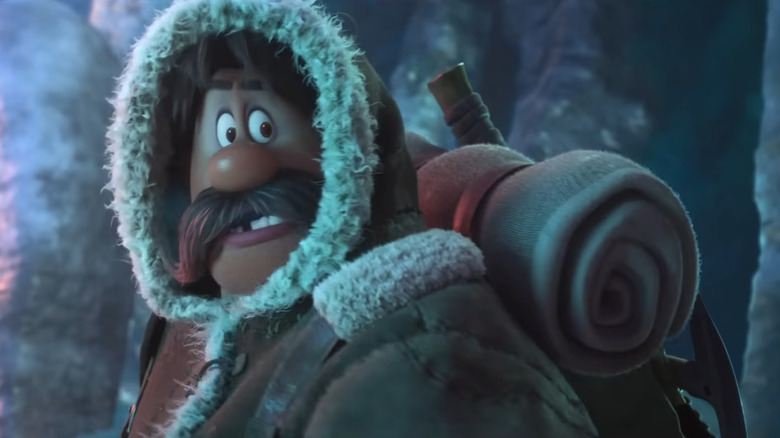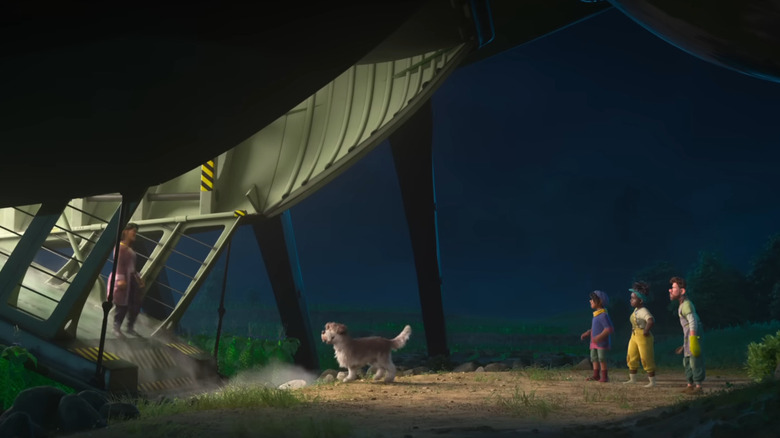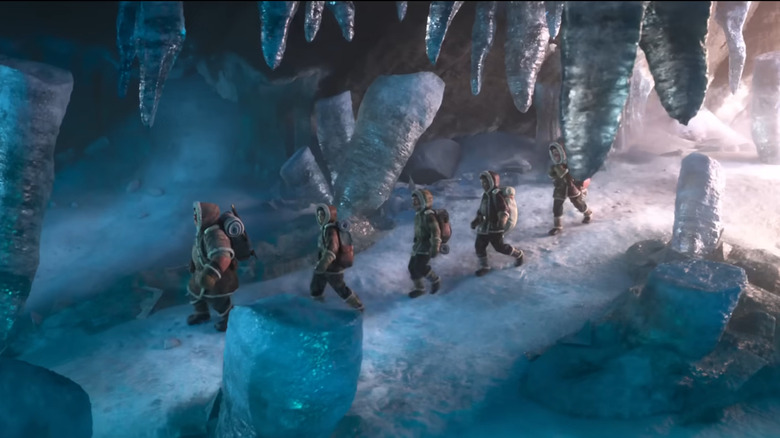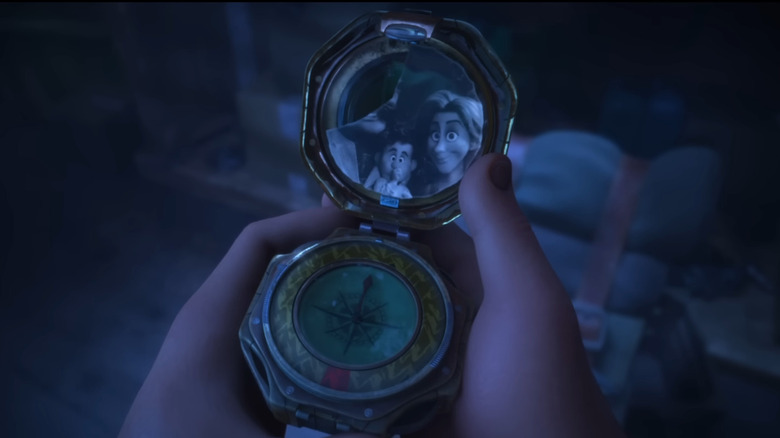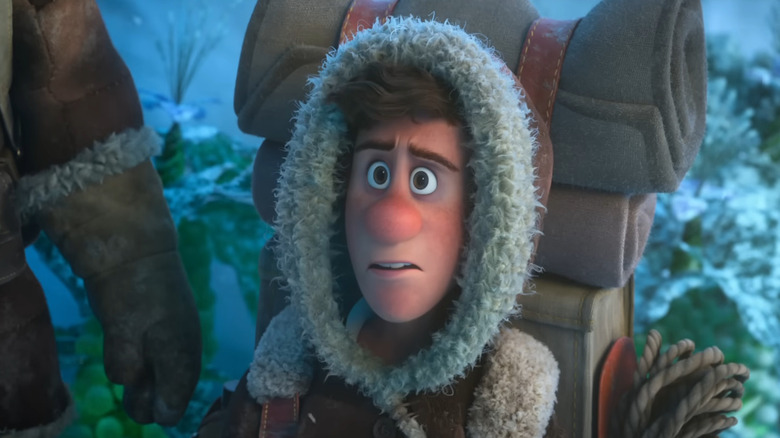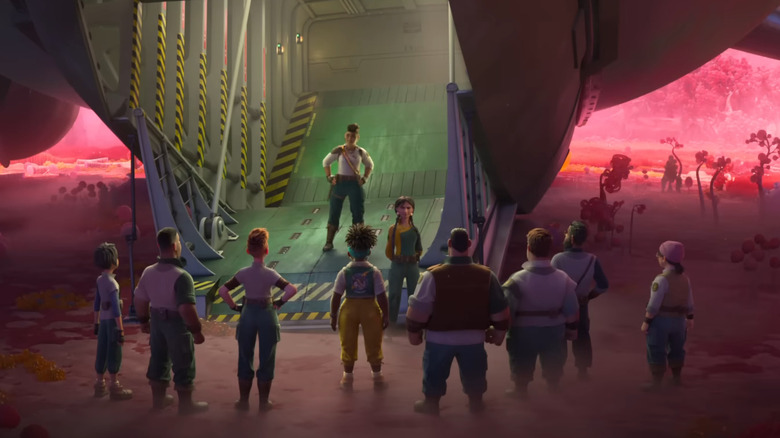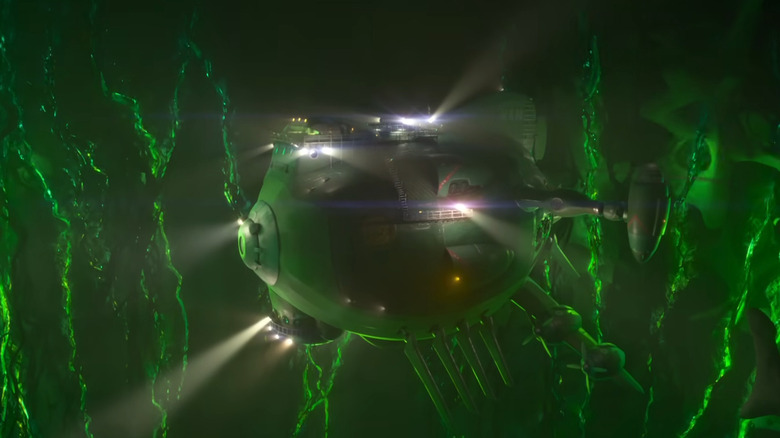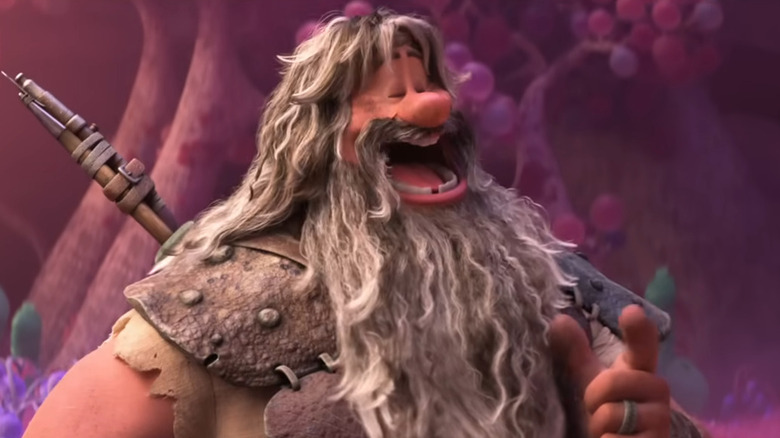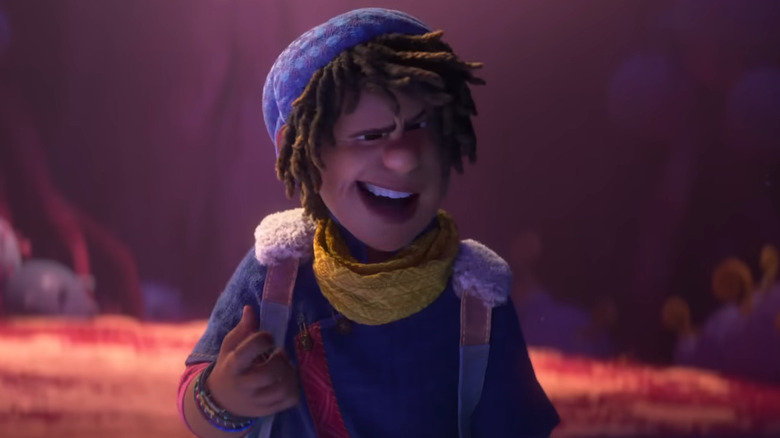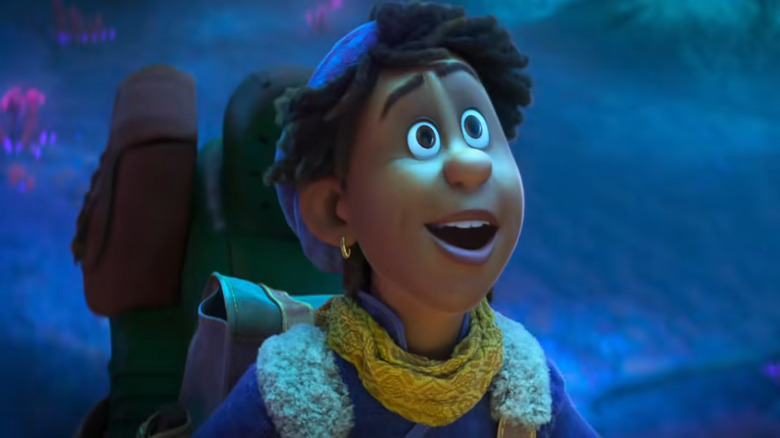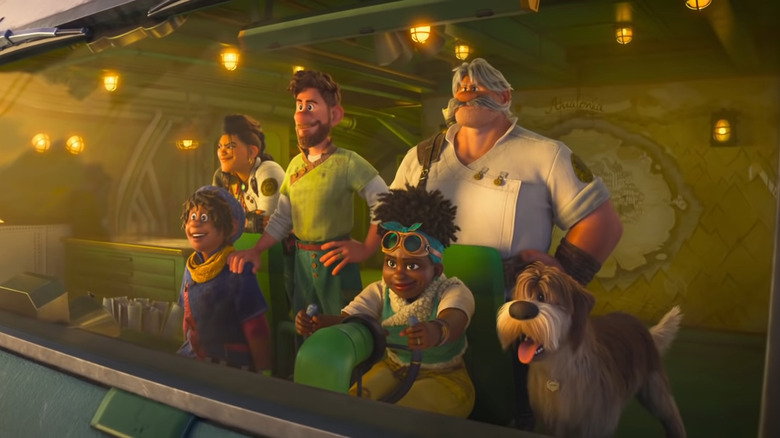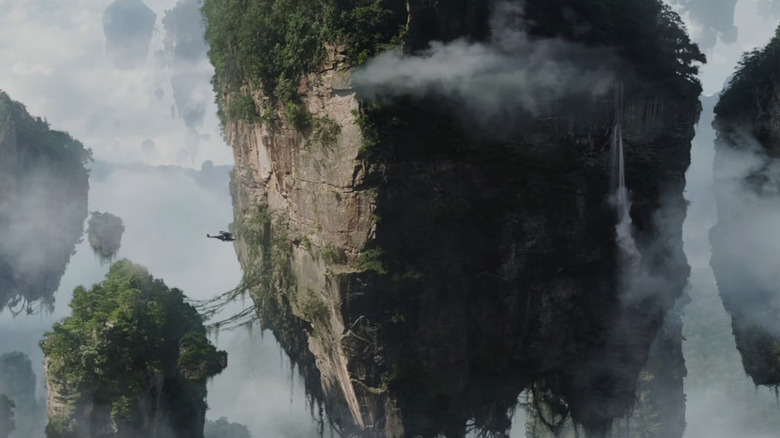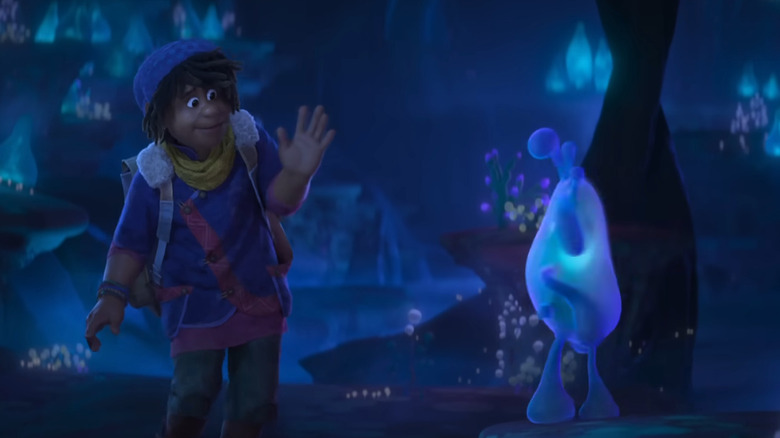Biggest Unanswered Questions In Strange World
The trailer for Disney's "Strange World" advertised the film as being "from the studio that brought you 'Big Hero 6' and 'Encanto.'" A more accurate comparison, though, might've been to align "Strange World" with the likes of "Atlantis: The Lost Empire" and "Treasure Planet." Like those two early 2000s entries in the filmography of Walt Disney Animation Studios, "Strange World" presents a dazzling animated adventure with exploration of an unknown realm as its centerpiece.
As such, the worldbuilding for the story in which "Strange World" takes place is thorough and complex. It's all in the name, but this narrative takes place somewhere very different from the world audiences are used to. In contrasting this fictional dreamscape with reality, filmmakers fill "Strange World" with its own set of mythologies and internal rules. It all helps to present an environment that, perhaps not realistic simply due to its genre, is nonetheless believable within the parameters it sets up for itself.
On the other side of that coin, though, as is the case with many sci-films before it, "Strange World" challenges the audience in keeping tabs on the many ways its setting differs from our own. The lore can be a lot to keep track of, and audiences might be left with some questions while trying to put everything together. Pertaining to its intricate worldbuilding, mind-bending epilogue, and quirky creatures, here are some unanswered questions we still have after seeing "Strange World."
This article contains spoilers for Disney's "Strange World."
Who is reading the comic book?
Similar to how many Disney movies begin and end with the opening and closing of a storybook, "Strange World" takes place within a comic book. One of its very first shots shows the pages of the comic book adventures of Jaeger Clade, the ultimate explorer. The following sequence provides some fun exposition as the animation is stylized to fit a vintage comic book aesthetic. Soon the action of the film settles into the typical look of modern-day computer-animated movies, with the comic book vibe ditched. That is, until the very end of the film, when the comic style returns and the camera pans out to show the comic book being closed.
The book is on the desk of someone who seems to be an explorer. While we only ever see their desk, it's enough to hint at what kind of identity the reader might have. Scattered around the comic book are various objects perfect for a discovery-laden voyage, including a compass. Who is this person? Are they on a quest of their own? Is the comic book a series? Are there other volumes about different explorers who exist in the same universe as the Clades? Bookending the film, literally, with this aesthetic is just a simple framing device, but the context with which it builds itself leads to some questions, the answers to which sound perfect for further developing "Strange World" — if there's any appetite for it to become a full-fledged Disney franchise, that is.
When and where does the story take place?
"Strange World" takes place in a land called Avalonia, which the Clades eventually discover is a huge, living landmass. Every known locale across Avalonia is actually a body part for this landmass. Before they make this discovery, it's obvious that the Clades are explorers — that's kind of their whole thing — but it's not until this revelation that the audience understands the extent to which the Clades are truly explorers in the sense of 16th century mapmakers filling in gaps of a largely undiscovered planet.
This plot point sets the story at odds with its otherwise futuristic sensibilities of spaceships, flamethrowers, and the like. Avalonia's tech seems advanced, but their knowledge beyond their own community seems limited and more like a fictionalized version of Earth's own exploration era. How much do they know about their own planet? Are they on Earth, or somewhere that just slightly resembles Earth? When all is said and done, these quandaries don't really matter to the story "Strange World" tells. It's a sci-fi tale about an unknown universe, and some of the intricacies of its lore are left to the imagination.
What did training look like for the crew of explorers?
In the prologue, mighty explorer Jaeger Clade leads an expedition to discover what's on the other side of Avalonia's mountains. Among the traveling pack is Jaeger's son, 15-year-old Searcher Clade. Before reaching their destination, Jaeger discovers a plant that comes to be known as pando. Realizing that leveraging the properties from this unknown natural resource could change everything for their community, Searcher suggests stopping the voyage short. They've found a viable path forward for their future, he argued.
His father, though, disagrees, saying that the crew trained their entire lives to do one thing: traveling to the other side of the mountains, where no one has ever been and he believes an even brighter future awaits them. Given the grandiose character that Jaeger Clade is depicted as being — somewhat of a more empathetic Gaston from "Beauty and the Beast," in that he is proudly a superlative of masculinity in every category possible, but not a complete jerk — it's fun to imagine what his training regimen might have been like. Surely he would have only taken the best of the best with him on his journey, and the selection process in choosing his crew was probably a lengthy ordeal with various tests of different abilities that Jaeger sees as necessary to being a valiant explorer.
How long did Searcher and his mom wait for Jaeger?
In the film's prologue, Jaeger Clade insists on continuing his dangerous voyage to the other side of the mountains while his son, Searcher, advocates that they've succeeded in their mission, even if they didn't reach their intended destination. Searcher goes home, and Jaeger pushes on, disappearing for 25 years.
In the time period immediately after this incident, Searcher and his mother must have held out some hope that Jaeger might return home. Whether he actually reached the mountains or gave up on the way, he'd come back to them, right? He's the world's greatest explorer, after all. Nothing can stop him.
The audience doesn't know the entire thought process of Searcher and his mom in those moments, nor is the audience privy to how long they waited for Jaeger before moving on with their lives. All we know is that Searcher's mom eventually settles down with someone named Sheldon, and in a quick bit of dialogue Searcher mentions that he and his mom believed Jaeger to be dead.
How did Searcher build a pando-focused community?
15-year-old Searcher discovers the pando plant on a snowy mountain in the middle of undeveloped land. After this discovery, the story jumps ahead 25 years. Searcher is 40 years old and a well-established businessman. He spends his days farming, harvesting pando as the economy's most valuable natural resource. In fact, Searcher has seemingly built an entire community on the back of this boom in pando. There's even a statue dedicated to Searcher in the town square. He's something of a local celebrity.
While Searcher's personality shows that he's more than capable of providing the ingenuity needed to make an impact of this scale, the story leaves a huge question mark within the gap of time from point A to point B. How did Searcher share his discovery of pando with the world? How did it become so central to the wellbeing of Avaloria? If this was Marvel, that kind of story gap would be practically begging for a prequel to show us the missing parts of Searcher's story.
Why didn't the crew believe Searcher and Ethan about the giant creature?
The movie's title delivers on its promise. Searcher, Ethan, and their crew find themselves in the middle of an unknown, strange world filled with sights that are unlike anything they know from back home. Plants regenerate immediately. Flying pink shapes zip through the sky and slimy blue creatures run about on the ground. The deeper they go, the more they all witness some pretty wild stuff.
Therefore, it's a little bizarre how unwilling they are to believe something that's only slightly weirder than what they've already seen. Searcher and Ethan make a life-altering discovery when they realize their entire existence is on top of, and inside, a huge, living creature. When they share this news with the crew, though, no one believes them. This seems odd, considering everything else in the sci-fi-heavy story the crew accepted without questioning.
What's the lore behind the landmass?
The audience learns discoveries about Avaloria and the planet at large along with the characters. We only ever know as much as they do, and by the end of the story, they're still learning, so that means so are we. That being said, there's a lot the Clades, and therefore the audience, still doesn't know about the landmass that Searcher and Ethan realize they inhabit.
Is every landmass on this planet a giant living creature? If so, do they communicate with each other (like we see in the Pixar short "Lava")? If Searcher and Ethan were to find the part of the territory that serves as the mouth of the landmass, would it be able to speak to them? Is the landmass even cognizant of its own mythology, or is it just kind of ... there? At the end of the film, we see that the landmass resembles a turtle. Are they all shaped like animals?
How will Jaeger Clade resolve his relationship status?
Jaeger Clade was married when he went on his big expedition 25 years ago and never came back. In the interim, his family assumed he died, and his wife moved on. Now she's with someone named Sheldon. The epilogue shows Jaeger re-entering civilization and visiting his ex-wife's house. He greets her at her doorstep with a bouquet of flowers, and a man, seemingly Sheldon, joins her at the door and picks up Jaeger in a bear hug, thrilled to see him.
There's no conversation in this exchange, and the moment is brief, so the audience is left to imagine their own scenario for what might become of this love triangle. Jaeger probably still has feelings for his wife, but he also doesn't seem to be the type to try to steal her away from Sheldon if she's truly happy with the way things are. Still, the whole thing has to be a little bit awkward.
Who made the first move: Ethan or Diazo?
Early in the film, Ethan and Diazo clearly like each other, but they're in that awkward pre-relationship phase. They flirt, they fumble through their words around each other, and Diazo even gives Ethan a small gift. At home, Ethan talks about Diazo a lot with his parents. They're not officially boyfriends, but all signs seem to indicate they might be soon.
Diazo is largely absent from the main action of the story, and he and Ethan remain just crushes before Ethan's big adventure. The next time we see Diazo is when the story jumps ahead to its epilogue. One year later, Ethan and Diazo are clearly in a relationship now, and might even live together, though details remain unclear. All the same, Ethan continues to lead explorations into the sublevel world with Diazo by his side. The audience is left to put the pieces together about how their relationship blossomed and who made the first move.
Where will Ethan's explorations lead him?
Ethan's new quest is no small feat. He leads an ambitious group of explorers and has started a bold new chapter of his life, away from his family's farm for the first time. Using skills taught to him by both his father and grandfather, we can assume Ethan will have scientific findings that benefit his community and his planet while simultaneously making history as he travels where no one else has before.
The audience's perspective on Ethan's new life goes straight to everything already in motion in the epilogue, which takes place a year after the main events of the film. The audience is left out of the loop as to how that journey came about, what sorts of decisions were involved in Ethan deciding firmly what he wants to do, and what was undoubtedly an emotional — but supportive — goodbye between Ethan and his parents.
Is there a secret code for the scene transitions?
From the very first sequence in "Strange World," the film leans into some of the kitschy qualities of old school filmmaking. Keeping with its vintage adventure theme, throughout the whole movie the scenes transition with a number of irises and swipes, sometimes happening in different directions. The iris sometimes engulfs the screen in its circle as it irises "in," and other times minimizes itself as the screen irises "out." Elsewhere, the intentionally cheesy screen wipe between scenes sometimes moves right to left, and other times moves left to right.
Is there symbolism for what type of transition happens based on what's happening in each respective scene? Is there any code to be found in the emotional themes that come before or after any given transition? Short of tracking every single transition with a fine-toothed comb, which is admittedly next to impossible upon a first time viewing in a movie theater, the question remains a mystery ... or, the transitions could just as easily simply rotate among each other.
Is the lingo an intentional reference to Avatar?
The economy in "Strange World" relies on a plant called pando, whose roots resemble giant vines in the sky within the sublevel world where most of the story takes place. The vines almost resemble the ones that connect the floating mountains in "Avatar," which leads to a lightbulb moment when thinking through the comparisons between the two films.
"Avatar" takes place on a distant planet called Pandora, where laws of nature are very different from what its visitors from Earth are used to. The more Jake Sully learns about Pandora, the more he begins to respect its ecosystem, its culture, and its people. The same, more or less, is true for the Clades as they find themselves in the fantastical underground world where the heart of pando seems to thrive. It's also, as it turns out, the place where pando is hurting the land around it (a theme mirroring climate change that might go over the head of young viewers). The characters then have to figure out a solution for protecting this delicate balance.
The similarities between the two films are, for the most part, incidental, and ordinarily wouldn't mean much. It's the name "pando," though, suspiciously similar to "Pandora," that might suggest that the conservation message at the center of "Strange World" is more of an homage to "Avatar" than a coincidence.
Was BB-8 an inspiration for Splat?
Ethan finds a friend in Splat, an amorphous creature he finds in the sublevel world. Splat is made from a goo-like substance, his movements squashing and stretching his body. He's quite enthusiastic in helping Ethan and the rest of the Clade crew navigate their way to the heart of the land in their quest to save the supply of pando.
Splat understands English, but doesn't speak it himself. Instead, he communicates in beeping noises that sound very similar to BB-8 from "Star Wars." It's not beyond the realm of possibility that BB-8 might have been used as an inspiration for Splat, as both characters' sounds and even personalities are similar. In some ways, Splat is also reminiscent of Morph, the squishy, floating pink creature in "Treasure Planet." Like Splat, Morph befriends an adventurer, Jim Hawkins, on a journey to a fantastical, unknown place.
